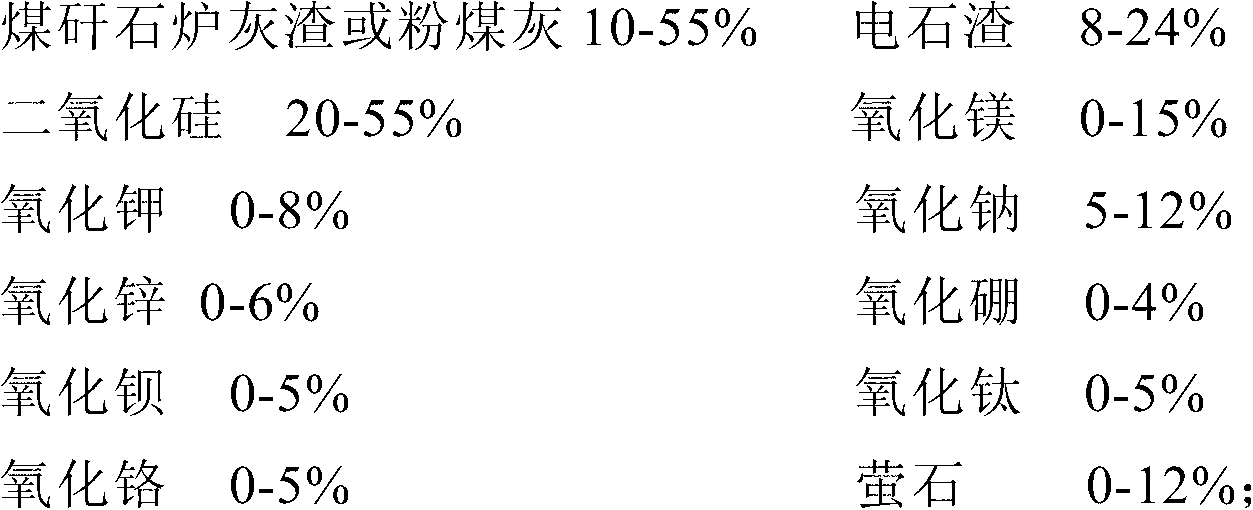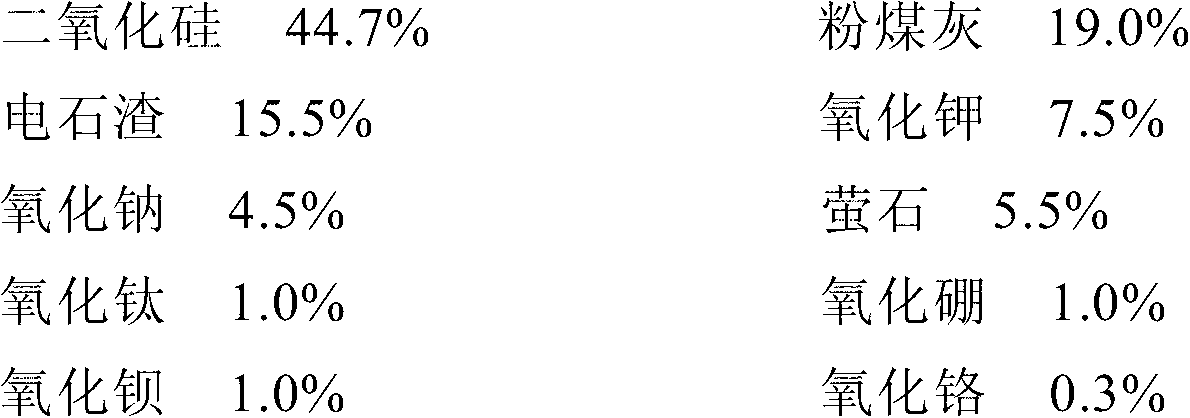Method for preparing microcrystalline glass from kaolin-type coal gangue or fly ash and carbide slag
A technology of glass-ceramic and coal gangue, which is applied in the field of glass-ceramic preparation, can solve the problems of high cost, energy waste, complicated process, etc., and achieve the effect of quality improvement
- Summary
- Abstract
- Description
- Claims
- Application Information
AI Technical Summary
Problems solved by technology
Method used
Image
Examples
Embodiment 1
[0031] Coal gangue and calcium carbide slag are selected as main raw materials, and a calendering method is used to produce a glass-ceramic plate. The steps of the preparation method are as follows:
[0032] 1. Pretreatment of coal gangue:
[0033] (1) Crushing the gangue into fine particles with a diameter less than 30 mm;
[0034] (2) The coal gangue fine particles are burned in a fluidized fluidized furnace (the heat released is used for other purposes) to obtain furnace ash;
[0035] (3) Crushing the furnace ash into a fine powder less than 40 mesh;
[0036] (4) Carry out deironing to fine powder with deironing machine;
[0037] (5) Sampling and testing, as one of the main raw materials for preparing glass-ceramic.
[0038] 2. Pretreatment of carbide slag:
[0039] Pass the calcium carbide slag through a 40-mesh sieve to remove the graphite electrode debris mixed in it, and use it as another main raw material for preparing glass-ceramics.
[0040] 3. Design the basic ...
Embodiment 2
[0059] Fly ash and carbide slag were selected as the main raw materials, and the glass-ceramic Buddha statue was prepared by casting method.
[0060] 1. Pretreatment of fly ash:
[0061] (1) Iron remover removes iron from fly ash.
[0062] (2) Sampling and testing, as the main raw material for preparing glass-ceramic pipes.
[0063] 2. Carbide slag is pretreated: Pass the carbide slag through a 40-mesh sieve to remove the graphite electrode debris mixed in it, and use it as another main raw material for preparing glass-ceramics.
[0064] 3. Design the basic formula of the glass-ceramic Buddha statue:
[0065]
[0066] Note: Potassium oxide, sodium oxide, and barium oxide can be replaced by corresponding potassium carbonate, sodium carbonate, and barium carbonate, and boron oxide can be replaced by boric acid.
[0067] 4. Add 10-20 mesh 3% coal gangue furnace ash to the basic formula.
[0068] 5. Mix all kinds of raw materials evenly in proportion.
[0069] 6. Melting: ...
Embodiment 3
[0083] Coal gangue and carbide slag are selected as main raw materials, and patterned glass-ceramic decorative panels are prepared by sintering.
[0084] 1. Pretreatment of coal gangue:
[0085] (1) Crushing the gangue into fine particles with a diameter less than 30 mm;
[0086] (2) The coal gangue fine particles are burned in a fluidized fluidized furnace (the heat released is used for other purposes) to obtain furnace ash;
[0087] (3) Crushing the furnace ash into a fine powder less than 40 mesh;
[0088] (4) Carry out deironing to fine powder with deironing machine;
[0089] (5) Sampling and testing, as one of the main raw materials for preparing glass-ceramic.
[0090] 2. Carbide slag is pretreated: Pass the carbide slag through a 40-mesh sieve to remove the graphite electrode debris mixed in it, and use it as another main raw material for preparing glass-ceramics.
[0091] 3. Determine the basic formula of glass-ceramics:
[0092] Silica 25.5% Coal gangue furnace a...
PUM
| Property | Measurement | Unit |
|---|---|---|
| size | aaaaa | aaaaa |
| flexural strength | aaaaa | aaaaa |
| flexural strength | aaaaa | aaaaa |
Abstract
Description
Claims
Application Information
 Login to View More
Login to View More - R&D
- Intellectual Property
- Life Sciences
- Materials
- Tech Scout
- Unparalleled Data Quality
- Higher Quality Content
- 60% Fewer Hallucinations
Browse by: Latest US Patents, China's latest patents, Technical Efficacy Thesaurus, Application Domain, Technology Topic, Popular Technical Reports.
© 2025 PatSnap. All rights reserved.Legal|Privacy policy|Modern Slavery Act Transparency Statement|Sitemap|About US| Contact US: help@patsnap.com



